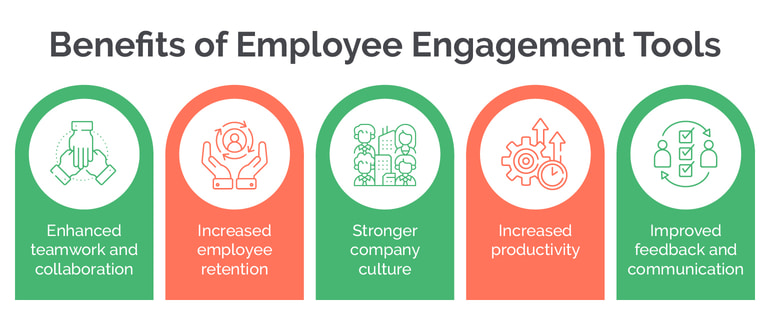
In today’s fast-paced digital economy, organizations are realizing that their most valuable asset isn’t technology or capital—it’s their people. Employee engagement is no longer seen as a “nice to have,” but rather a crucial factor in productivity, innovation, and long-term business success. This has led to the rise of platforms, apps, and systems collectively referred to as employee engagement tools.
The Growing World of Employee Engagement Tools represents a massive shift in how companies understand, measure, and act on workplace culture. From small startups to global corporations, these tools are reshaping how leaders connect with employees and foster stronger collaboration, belonging, and motivation.
Why Employee Engagement Matters More Than Ever
Employee engagement directly impacts retention, performance, and overall workplace morale. A disengaged workforce can result in higher turnover, increased absenteeism, and decreased profitability. On the other hand, companies that prioritize engagement often see improved productivity, higher customer satisfaction, and stronger financial performance.
According to research by Gallup, highly engaged teams show 21% greater profitability than their less engaged counterparts. These numbers make it clear: businesses can no longer afford to ignore the importance of engagement strategies.
Evolution of Digital Platforms for Workforce Engagement
The early efforts of engagement involved annual surveys, suggestion boxes, and basic recognition programs. But these methods were often static, one-directional, and failed to capture real-time employee sentiment.
Today, modern engagement tools go far beyond surveys. They use artificial intelligence, analytics, gamification, and mobile-first experiences to make feedback loops continuous, transparent, and actionable. Many integrate with platforms employees already use—like Slack, Microsoft Teams, and Zoom—making participation seamless.
Just like how social networking sites revolutionized communication outside of work (see Wikipedia), employee engagement tools are transforming the way employees connect, collaborate, and thrive within organizations.
Key Benefits of Modern Employee Engagement Solutions
- Real-Time Feedback: Employees can share their thoughts instantly, rather than waiting for quarterly or annual reviews.
- Recognition Programs: Peer-to-peer recognition boosts morale and encourages positive behaviors.
- Learning & Development: Many tools include career pathing, training modules, and mentorship matching.
- Wellness Support: Some platforms integrate wellness resources, stress management tips, and health monitoring.
- Data-Driven Insights: Leaders gain actionable insights on employee satisfaction, performance, and potential turnover risks.
Emerging Trends in the Employee Engagement Space
As engagement tools evolve, several exciting trends are shaping the market:
- AI-Powered Sentiment Analysis: Platforms now analyze employee comments and feedback to detect tone, morale, and emerging issues.
- Personalized Employee Journeys: Instead of one-size-fits-all, tools create tailored experiences for employees based on role, department, and preferences.
- Gamification: Points, rewards, and challenges encourage active participation and make work more engaging.
- Integration with HR Tech: Engagement platforms often link with payroll, performance management, and onboarding systems for a unified experience.
- Hybrid & Remote Engagement: Tools are increasingly designed to support distributed teams, ensuring remote employees feel just as connected as in-office staff.
How Businesses Are Leveraging Engagement Platforms
Organizations are using these tools to:
- Build stronger company cultures by recognizing achievements regularly.
- Reduce attrition by identifying disengaged employees before they leave.
- Support managers with coaching and development dashboards.
- Strengthen cross-department collaboration through communication tools.
- Monitor diversity, equity, and inclusion (DEI) metrics in real-time.
Challenges in Adopting Engagement Tools
While the benefits are clear, implementation isn’t always straightforward. Common challenges include:
- Adoption Resistance: Employees may initially see new platforms as “extra work.”
- Data Privacy Concerns: Collecting employee feedback raises questions about confidentiality.
- Integration Issues: Some companies struggle to connect new tools with existing HR systems.
- Cost and ROI Measurement: Leaders need to ensure these investments directly impact performance and retention.
Future of the Employee Engagement Landscape
The future of engagement platforms is heading toward holistic employee experience ecosystems. Rather than being standalone apps, these solutions will integrate seamlessly across all touchpoints of the employee journey—from hiring and onboarding to career growth and alumni networks.
According to the latest insights into the Employee engagement software market, the sector is expected to grow rapidly as organizations continue to prioritize culture, engagement, and retention in increasingly competitive industries.
The next generation of tools will likely harness machine learning, predictive analytics, and even virtual reality to create immersive engagement experiences.
The Growing World of Employee Engagement Tools reflects a fundamental shift in how businesses view and value their people. What was once managed through static surveys has now transformed into dynamic, AI-powered platforms that shape real-time workplace culture.
By investing in these tools, companies not only boost performance but also create workplaces where employees feel valued, motivated, and inspired. In an era where top talent has more choices than ever, engagement isn’t optional—it’s the future of work.




